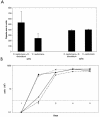Cryptococcus neoformans virulence is enhanced after growth in the genetically malleable host Dictyostelium discoideum
- PMID: 12933827
- PMCID: PMC187309
- DOI: 10.1128/IAI.71.9.4862-4872.2003
Cryptococcus neoformans virulence is enhanced after growth in the genetically malleable host Dictyostelium discoideum
Abstract
Cryptococcus neoformans is an encapsulated, environmental fungus that can cause life-threatening meningitis. Pathogenicity of C. neoformans for macrophages and vertebrate hosts may be a mechanism selected in evolution for protection against environmental predators. In this study, we investigated whether Dictyostelium discoideum could serve as an alternate host for C. neoformans. D. discoideum has a defined genetic system which provides significant advantages for the study of fungus-amoeba interactions. Our results show that D. discoideum is susceptible to infection with C. neoformans and that the interactions are similar to those described previously for this fungus with macrophages and Acanthamoeba castellanii. Acapsular C. neoformans cells did not replicate when coincubated with D. discoideum. However, incubation of acapsular C. neoformans with D. discoideum mutants defective in myosin VII synthesis resulted in infection, validating the concept that avirulent organisms can be virulent in impaired hosts even at the unicellular level. Phagocytosis of C. neoformans by D. discoideum could be inhibited with capsule-specific antibodies and various sugars. Passage of an encapsulated C. neoformans strain through D. discoideum cultures increased virulence and was accompanied by larger capsules and faster time to melanization. These results add to the evidence implicating soil ameboid predators as important factors for the maintenance of C. neoformans virulence in the environment and suggest that D. discoideum promises to be an extremely useful system for studying the interaction of C. neoformans with phagocytic cells.
Figures








Similar articles
-
Amoeba Predation of Cryptococcus neoformans Results in Pleiotropic Changes to Traits Associated with Virulence.mBio. 2021 Apr 27;12(2):e00567-21. doi: 10.1128/mBio.00567-21. mBio. 2021. PMID: 33906924 Free PMC article.
-
Cryptococcus neoformans Escape From Dictyostelium Amoeba by Both WASH-Mediated Constitutive Exocytosis and Vomocytosis.Front Cell Infect Microbiol. 2018 Apr 9;8:108. doi: 10.3389/fcimb.2018.00108. eCollection 2018. Front Cell Infect Microbiol. 2018. PMID: 29686972 Free PMC article.
-
Divalent Metal Cations Potentiate the Predatory Capacity of Amoeba for Cryptococcus neoformans.Appl Environ Microbiol. 2018 Jan 17;84(3):e01717-17. doi: 10.1128/AEM.01717-17. Print 2018 Feb 1. Appl Environ Microbiol. 2018. PMID: 29150507 Free PMC article.
-
Dictyostelium as host model for pathogenesis.Cell Microbiol. 2005 Mar;7(3):307-14. doi: 10.1111/j.1462-5822.2005.00493.x. Cell Microbiol. 2005. PMID: 15679834 Review.
-
Eat, kill or die: when amoeba meets bacteria.Curr Opin Microbiol. 2008 Jun;11(3):271-6. doi: 10.1016/j.mib.2008.05.005. Epub 2008 Jun 10. Curr Opin Microbiol. 2008. PMID: 18550419 Review.
Cited by
-
Interaction of Talaromyces marneffei with free living soil amoeba as a model of fungal pathogenesis.Front Cell Infect Microbiol. 2022 Oct 3;12:1023067. doi: 10.3389/fcimb.2022.1023067. eCollection 2022. Front Cell Infect Microbiol. 2022. PMID: 36262181 Free PMC article.
-
Capsules from pathogenic and non-pathogenic Cryptococcus spp. manifest significant differences in structure and ability to protect against phagocytic cells.PLoS One. 2012;7(1):e29561. doi: 10.1371/journal.pone.0029561. Epub 2012 Jan 12. PLoS One. 2012. PMID: 22253734 Free PMC article.
-
DNA mutations mediate microevolution between host-adapted forms of the pathogenic fungus Cryptococcus neoformans.PLoS Pathog. 2012;8(10):e1002936. doi: 10.1371/journal.ppat.1002936. Epub 2012 Oct 4. PLoS Pathog. 2012. PMID: 23055925 Free PMC article.
-
Mutators Enhance Adaptive Micro-Evolution in Pathogenic Microbes.Microorganisms. 2022 Feb 15;10(2):442. doi: 10.3390/microorganisms10020442. Microorganisms. 2022. PMID: 35208897 Free PMC article. Review.
-
Iron metabolism and resistance to infection by invasive bacteria in the social amoeba Dictyostelium discoideum.Front Cell Infect Microbiol. 2013 Sep 19;3:50. doi: 10.3389/fcimb.2013.00050. eCollection 2013. Front Cell Infect Microbiol. 2013. PMID: 24066281 Free PMC article. Review.
References
-
- Abadi, J., and L. Pirofski. 1999. Antibodies reactive with the cryptococcal capsular polysaccharide glucuronoxylomannan are present in sera from children with and without human immunodeficiency virus infection. J. Infect. Dis. 180:915-919. - PubMed
-
- Aizawa, H., Y. Fukui, and I. Yahara. 1997. Live dynamics of Dictyostelium cofilin suggests a role in remodeling actin latticework into bundles. J. Cell Sci. 110:2333-2344. - PubMed
-
- Aizawa, H., M. Sameshima, and I. Yahara. 1997. A green fluorescent protein-actin fusion protein dominantly inhibits cytokinesis, cell spreading, and locomotion in Dictyostelium. Cell Struct. Funct. 22:335-345. - PubMed
-
- Allen, D. M., and H. H. Chng. 1993. Disseminated Mycobacterium flavescens in a probable case of chronic granulomatous disease. J. Infect. 26:83-86. - PubMed
-
- Brazill, D. T., D. R. Caprette, H. A. Myler, R. D. Hatton, R. R. Ammann, D. F. Lindsey, D. A. Brock, and R. H. Gomer. 2000. A protein containing a serine-rich domain with vesicle fusing properties mediates cell cycle-dependent cytosolic pH regulation. J. Biol. Chem. 275:19231-19240. - PubMed
Publication types
MeSH terms
Substances
Grants and funding
LinkOut - more resources
Full Text Sources

